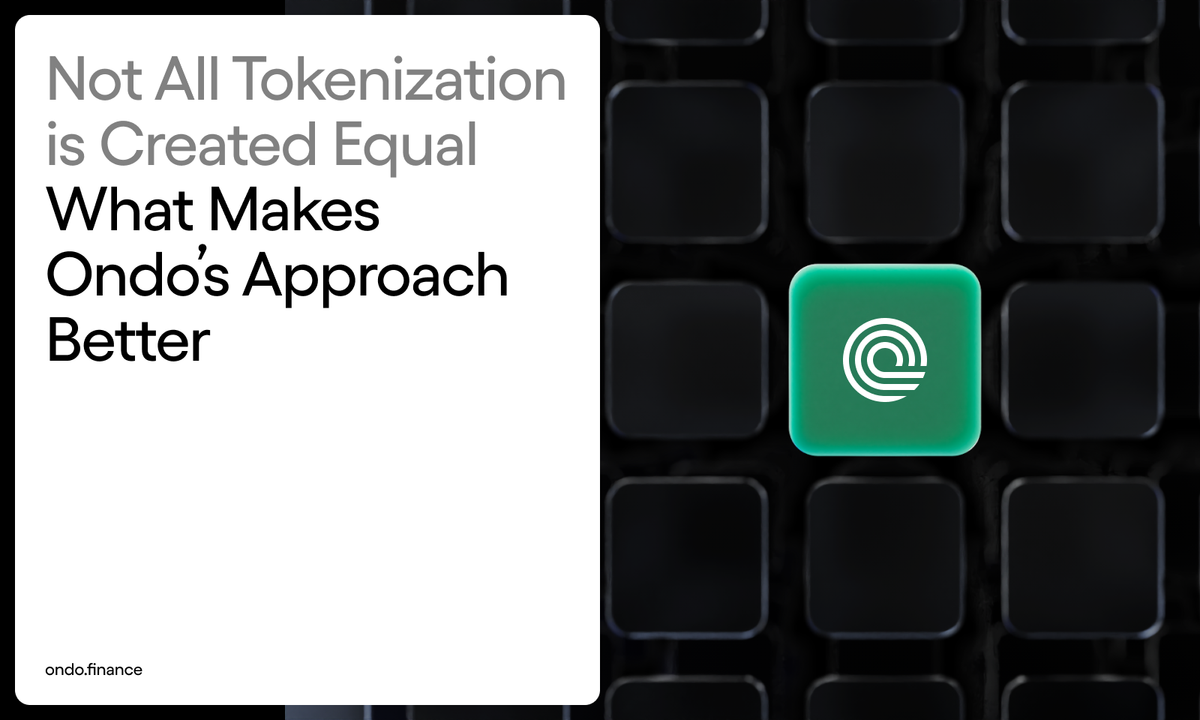Not All Tokenization is Created Equal: What Makes Ondo’s Approach Better


Not all tokenized equities are created equal. Interest in the tokenization of securities is surging — most recently sparked by Republic’s launch of a SpaceX-linked token. But tokenization models vary widely, creating confusion, especially around “wrapped” stocks vs “native” models. As we prepare to launch our Global Markets platform, we’ve spent a lot of time thinking about how best to bring real-world assets like securities onchain in a way that’s practical, secure, with liquidity, and at scale.
Our view: when designed properly, wrapped token models are the best way to achieve the goal of using tokenization to expand access to traditional securities at this moment in time. In this post, we unpack why.
Start With the End In Mind
It’s important to keep in mind that tokenization—regardless of form—shouldn’t be the goal per se. Rather, we need to ask ourselves why we want to tokenize assets in the first place. For us, the answer is clear: it’s about improving access to all of the features of today’s (already pretty incredible) financial markets. Those features include things like broad asset selection, thoughtful investor protections, and liquidity that matches or exceeds that which exists on existing trading venues. Finally, all else being equal, we want to start bringing the benefits of this increased access to investors sooner rather than later.
Ultimately, it’s really the last of these, speed to scale, where native tokenization runs into the biggest challenges. There are multiple reasons for this, including regulatory complexities, additional infrastructure burden, incompatibility with existing financial infrastructure, challenges for issuers of managing two parallel registries, and more. But the biggest issue is that in many instances of native tokenization, each individual issuer of the security (e.g. Apple, Tesla, Nike) must agree to tokenize their own equity and get comfortable that they are doing it in a compliant way.
With wrapped tokenization, you don’t need issuer cooperation. You can tokenize already publicly traded assets as long as you hold them with a licensed custodian and follow securities and other laws. This approach is simply faster and more scalable.
However, not all approaches to wrapped tokenization are the same, and here the details matter.
Consider the design of the Republic SpaceX token. To be sure, there are things we applaud about this model: it’s attempting to provide accessibility to an in-demand private company and is operating within a clear regulatory exemption provided in the 2012 JOBS Act. Unfortunately, there is limited transparency that the token issuer (RepublicX LLC) actually holds enough (or any?) SpaceX stock to fully back the tokens (and no contractual indication that this is the case), and no clear protections for tokenholders in the event that the tokens weren’t fully backed or if RepublicX (or Republic itself) went out of business or declared bankruptcy.
Compare this approach with the design of our Global Markets (GM) tokens. They will be redeemable on-demand, 24 hours a day, 5 days a week, and are fully backed by the underlying shares (and any cash in transit) they reference. These shares, in turn, will be held with US licensed and regulated broker-dealers. An independent third-party Verification Agent, will review and provide a report on this backing every business day. In addition, an independent third-party Collateral Agent has a first-priority security interest in the underlying shares (and any cash in transit) for the benefit of the tokenholders; this means that, in certain events of default (e.g. the backing of the tokens fails, or the issuer cannot fulfill its obligation to service a redemption request), the Collateral Agent is contractually empowered to foreclose on that collateral, sell it, and distribute the proceeds to tokenholders. Both our GM tokens and the Republic tokens are technically “wrapped”, but extremely different in practice.
Wrapping Is Not New
Critics of wrapped tokens argue that they reintroduce centralization and counterparty risk, limit composability due to permissioning, add legal and regulatory complexity, compromise crypto’s original ideals, and often lack transparency around reserves. While these concerns often have validity—especially for poorly designed wrappers—they can be mitigated through strong legal structuring, regulated custodianship, daily third-party verification, enforceable redemption rights, and thoughtful permissioning that balances compliance with usability.
It’s also worth pointing out that “wrapping” is already a deeply embedded concept in traditional financial markets. American Depositary Receipts (ADRs) and Global Depositary Receipts (GDRs) are classic examples of wrapped structures, where institutions issue tradable instruments backed 1:1 by underlying foreign equities. In the US, most investors are not even legal owners of their stocks in the strictest sense—they are what’s known as beneficial owners: their holdings are recorded by brokers, who in turn are recorded by securities depositories like the Depository Trust Company (DTC). The DTC’s nominee, Cede & Co., is the actual legal holder of nearly all public equities. These multiple layers are wrappers—and they’re trusted because they’re regulated and transparent. So in reality, the financial world already relies on “wrapping” to enable access, scale, and trust. The key question isn’t whether wrapping is legitimate—it’s whether it’s done well.
Outcomes Over Labels
Ondo is committed to setting the highest standard in tokenization, demonstrating that thoughtful, transparent, and well-regulated wrapped tokens not only offer immediate benefits but also pave the way for broader financial innovation. By prioritizing outcomes over labels, Ondo is leading the transition toward a more open, accessible, and efficient financial future.

